DDGS show greater antioxidant capacity than in corn grain
Part 7 in the series “What have we learned about feeding DDGS to pigs over the past 20 years?”
December 13, 2018
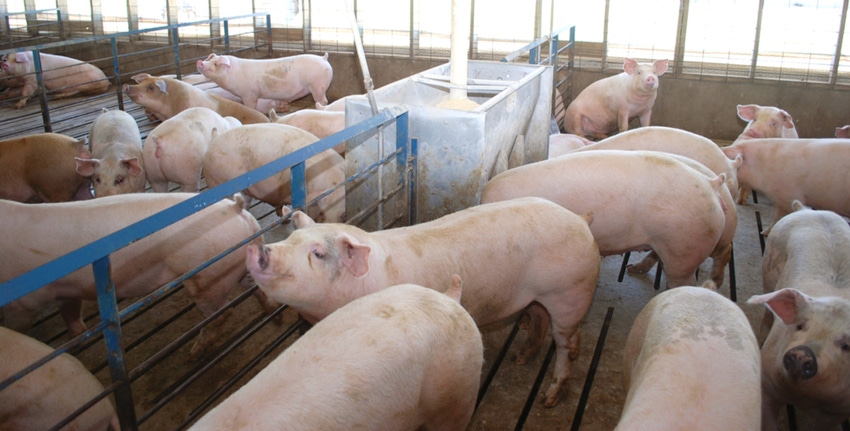
By Jerry Shurson, University of Minnesota Department of Animal Science
The fatty acid composition of dried distillers grains with solubles is important for several reasons including its contribution to metabolizable and net energy content, effects on pork fat firmness in growing-finishing pigs, and susceptibility to lipid oxidation during production, transport and storage.
As shown in Table 1, the major fatty acids present in DDGS corn oil are linoleic acid (54%), oleic acid (26%) and palmitic acid (14%). Linoleic and oleic acids are unsaturated fatty acids that contribute to the high energy content of DDGS, but also cause the oil in DDGS to be susceptible to oxidation. Linoleic acid is the primary contributor to soft pork fat when feeding DDGS to growing-finishing pigs. The fatty acid profile does not appreciably differ between high-oil (>10% crude fat) and reduced-oil (<10% crude fat) DDGS sources, but ether extract digestibility ranges from 53 to 81% among sources (Kerr et al., 2013).
Although there is no detectable eicosapentaenoic acid concentrations in DDGS oil, there are small amounts of docohexaenoic acid present, which is a physiologically important omega-3 fatty acid for neural, retinal and immune functions. There are minimal average differences of indicators of lipid oxidation (free fatty acid content, thiobarbituric acid reactive substance and peroxide value) among high-oil (> 10% crude fat) and reduced-oil (< 10% crude fat) DDGS sources, but there is considerable variation in lipid oxidation among DDGS sources.
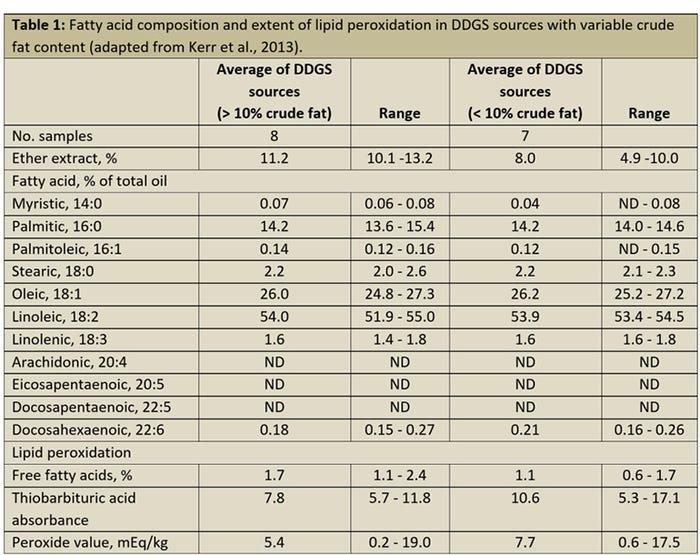
For a more comprehensive analysis of lipid oxidation among DDGS sources, Song and Shurson (2013) analyzed corn oil extracted from 31 corn DDGS sources and compared these data with a corn grain reference sample (Table 2). The correlations between Minolta L* and b* and peroxide value were -0.63 and -0.57, respectively, and greater for TBARS (r = -0.73 and -0.67, respectively). These significant negative correlations between color measurements and peroxidation measurements of DDGS suggest that color may be a general indicator of the extent of lipid oxidation in DDGS sources because brown-colored oxypolymers are produced during the polymerization reactions during lipid oxidation (Buttkus, 1975; Khayat and Schwall, 1983). When DDGS is stored for 28 days under hot (38.6 C) and humid (94% relative humidity), oxidation of oil in DDGS can be reduced by about 50% with the addition of commercial antioxidants containing t-butylhydroquinone or ethoxyquin and TBHQ (Hanson et al., 2015a).
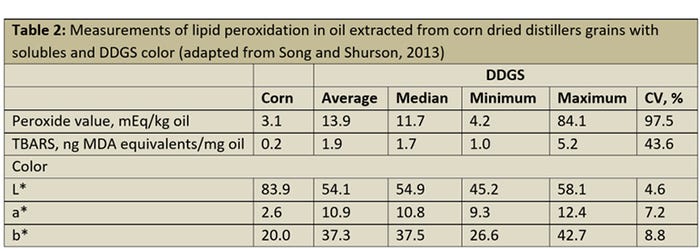
However, when Song et al. (2013) fed 30% DDGS diets using the most oxidized source of DDGS (which also contained 0.95% sulfur) from the Song and Shurson (2013) study, no negative effects on growth performance of weaned pigs were observed. The lack of a growth performance response was attributed to an increase in sulfur-containing antioxidant compounds resulting from feeding DDGS, and additional supplemental vitamin E was not necessary to prevent a reduction in growth performance. Feeding DDGS diets to sows and their litters after weaning has occasionally been implicated as a cause for developing Mulberry heart disease (vitamin E and selenium nutritional deficiency) in weaned pigs. However, Hanson et al. (2015b) fed diets containing a highly oxidized DDGS source at 40% during gestation, 20% during lactation and 30% in nursery diets of offspring for a seven-week nursery feeding period and observed no effect on pigs developing Mulberry heart disease.
These results suggest that although significant lipid oxidation occurs in DDGS, it does not appear to negatively affect growth performance and health of weaned pigs. It is possible that the relatively high natural antioxidants found in DDGS are sufficient to overcome potential negative effects of feeding oxidized oil in DDGS to pigs.
Installments in the DDGS series
Part 1: 20 years of DDGS lessons in pig diets
Part 2: Varied energy and digestible amino acids levels in DDGS manageable
Part 3: Work continues to evaluate performance responses from feeding DDGS
Part 4: Managing carcass yield, pork fat quality when feeding corn DDGS
Part 5: Reaching an understanding of fiber characteristics of corn DDGS
Part 6: Enzymes, pre-treatment improve fiber and nutrient digestibility
Part 7: DDGS show greater antioxidant capacity than in corn grain
Natural antioxidant and phytochemical composition of DDGS
While the primary role of feed ingredients is to provide sufficient amounts of energy and digestible nutrients to meet the requirements of animals, some feed ingredients also contain compounds that provide additional physiological benefits beyond the nutrients they provide to the diet. These compounds are sometimes described as having “functional” or nutraceutical properties (i.e. nutritional and pharmaceutical). There are several bioactive compounds in corn that provide health benefits including vitamin E, ferulic acid and carotenoids. These compounds, along with others, may collectively contribute to the relatively high antioxidant capacity and potential health benefits of DDGS.
Limited data on phytochemical content and antioxidant capacity of DDGS are available. However, there is increasing interest among nutritionists in understanding the potential role of these phytochemical components for reducing oxidative stress and improving gut health and immune system responses from feeding DDGS diets to pigs. Furthermore, initiatives are underway in some commercial companies to develop methods for extracting and concentrating some of the lipid-based phytochemicals for use as feed additives in animal diets.
Initial evidence suggests that DDGS contain significant amounts of various antioxidant compounds that may provide health benefits while preventing oxidative stress from feeding oxidized oil present in some DDGS sources to animals. Winkler-Moser and Breyer (2011) conducted one of the first studies to quantify various natural antioxidants and phytochemicals in DDGS.
These researchers obtained a sample of DDGS from a commercial ethanol plant and conducted an extensive analysis to determine the fatty acid profile, tocopherols, tocotrienols, carotenoids, oxidative stability index and phytosterols in the extracted oil (Table 3). Tocopherols are the predominant antioxidants present in oils (Kamal-Eldin, 2006), and are important in minimizing lipid oxidation under pro-oxidant conditions. Tocotrienols also serve as antioxidants (Schroeder et al., 2006), and appear to contribute to reducing blood cholesterol, preventing cancer and protecting the neural system in humans (Sen et al., 2000). The major carotenoids in corn oil are lutein and zeaxanthin, which have been shown to protect against age induced macular degeneration and cataracts in humans (Zhao et al., 2006). Beta-carotene and beta-cryptoxanthin are precursors to vitamin A (Bendich and Olson, 1989), and all carotenoids have been shown to have beneficial health effects including increased antioxidant activity, immune response and protection against several types of cancer (Bendich and Olson, 1989; Rao and Rao, 2007). Phytosterols are valuable constituents in functional foods because of their ability to reduce blood cholesterol and block cholesterol re-absorption from the lower gastrointestinal tract of humans (Gylling and Miettinen, 2005). Steryl ferulates assist in the cholesterol reducing properties of phytosterols (Rong et al., 1997) and also have antioxidant activity (Nyström et al., 2005). In one of our recent studies, Shim et al. (2018) determined the variability in antioxidant capacity, and tocopherol, tocotrienol, xanthophylls and ferulic acid content among 16 sources of DDGS and compared these values with those in corn grain (Table 4). Results from this study showed that there is substantial variability in concentrations of these phytochemical compounds among DDGS sources, but concentrations are two- to three-fold greater than found in corn.
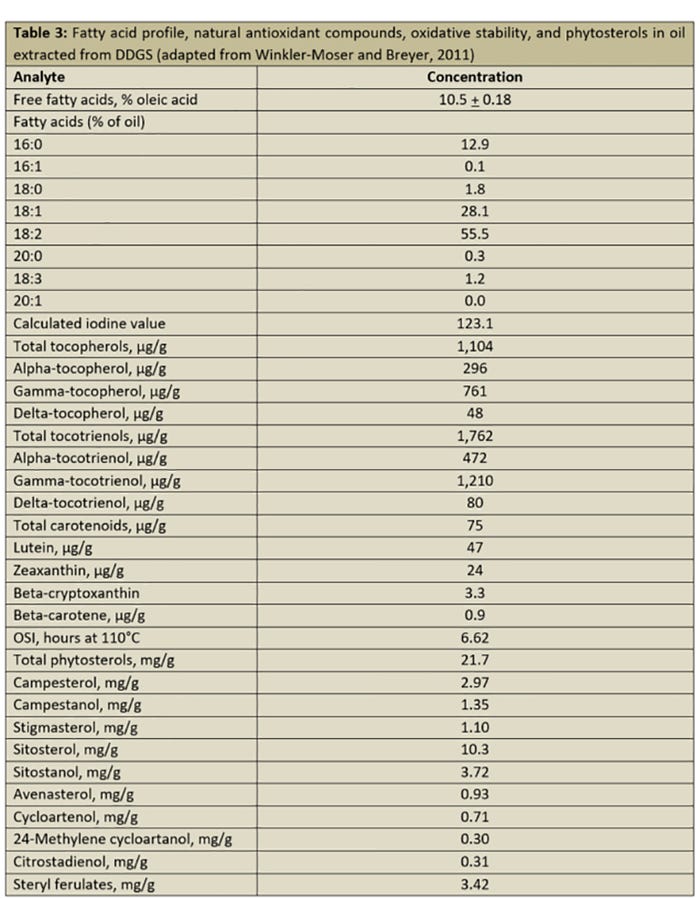
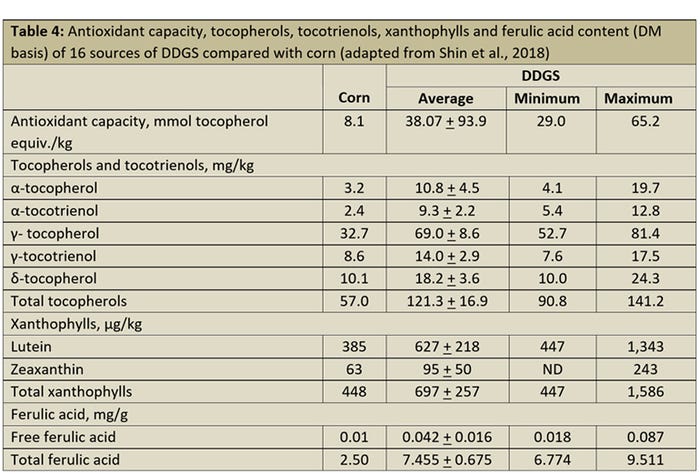
In summary, corn oil in DDGS contains high concentrations of polyunsaturated fatty acids, especially linoleic acid, which causes it to be susceptible to oxidation and reduce pork carcass fat firmness. Commercially available synthetic antioxidants have been shown to be partially effective in reducing lipid oxidation in DDGS when stored under hot and humid conditions. However, several studies have shown that feeding highly oxidized DDGS sources has no adverse effects on pig growth performance and does not contribute to the development of Mulberry heart disease. In fact, corn DDGS has much greater antioxidant capacity than found in corn grain, which may contribute to beneficial health effects in pigs. However, further research is needed to understand the potential contributions of tocopherols, tocotrienols, carotenoids, ferulic acid and phytosterols to these effects.
References
Bendich, A., and J.A. Olson. 1989. Biological actions of carotenoids. FASEB J. 3:1927-1932.
Buttkus, H.A. 1975. Fluorescent lipid autoxidation products. J. Am. Oil Chem. Soc. 23:823-825.
Gylling, H., and T.A. Miettinen. 2005. The effect of plant stanol- and sterol-enriched foods on lipid metabolism, serum lipids and coronary heart disease. Ann. Clin. Biochem. 42:254-263.
Hanson, A.R., P.E. Urriola, L.J. Johnston, and G.C. Shurson. 2015a. Impact of synthetic antioxidants on lipid peroxidation of distiller’s dried grains with solubles and distiller’s corn oil stored under high temperature and humidity conditions. J. Anim. Sci 93:4070-4078.
Hanson, A.R., L. Wang, L.J. Johnston, S.K. Baidoo, J. L. Torrison, C. Chen, and G.C. Shurson. 2015b. Effects of feeding peroxidized dried distillers grains with solubles to sows and progeny on growth performance and metabolic oxidative status of nursery pigs. J. Anim. Sci. 93:135-146.
Kamal-Eldin, A. 2006. Effect of fatty acids and tocopherols on the oxidative stability of vegetable oils. Eur. J. Lipid Sci. Technol. 58:1051-1061.
Kerr, B.J., W.A. Dozier, III, and G.C. Shurson. 2013. Effects of reduced-oil corn distillers dried grains with solubles composition on digestible and metabolizable energy value and prediction in growing pigs. J. Anim. Sci. 91:3231-3243.
Khayat, A., and D. Schwall. 1983. Lipid oxidation in seafood. Food technol. 37:130-140.
Nyström, L., Mäkinen, A.-M. Lampi, and V. Piironen. 2005. Antioxidant activity of steryl ferulate extracts from rye and wheat bran. J. Agric. Food Chem. 53:2503-2510.
Rao, A.V., and L.G. Rao. 2007. Carotenoids and human health. Pharmacol. Res. 55:207-216.
Rong, N., L.M. Ausman, and R.J. Nicolosi. 1997. Oryzanol decreases cholesterol absorption and aortic fatty streaks in hamsters. Lipids 32:303-309.
Schroeder, M.T., E.M. Becker, and L.H. Skibsted. 2006. Molecular mechanisms of antioxidant synergism of tocotrienols and carotenoids in palm oil. J. Agric. Food Chem. 54:3445-3453.
Sen, C.K., S. Khann, an S. Roy. 2000. Tocotrienols in health and disease: The other half of the natural vitamin E family. Mol. Aspects med. 28:692-798.
Shin, E.C., G.C. Shurson, and D.D. Gallaher. 2018. Antioxidant capacity and phytochemical content of 16 sources of maize dried distillers grains with solubles. Anim. Nutr. (in press)
Song, R. and G.C. Shurson. 2013. Evaluation of lipid peroxidation level in corn dried distillers grains with solubles. J. Anim. Sci. 91:4383-4388.
Song, R., C. Chen, L. Wang, L.J. Johnston, B.J. Kerr, T.E. Weber, and G.C. Shurson. 2013. High sulfur content in corn dried distillers grains with solubles protects against oxidized lipids in DDGS by increasing sulfur-containing antioxidants in nursery pigs. J. Anim. Sci. 91:2715-2728.
Winkler-Moser, J.K., and L. Breyer. 2011. Composition and oxidative stability of crude oil extracts of corn germ and distillers grains. Industrial Crops and Prod. 33:572-578.
Zhao, D.Y., P. Bhosal, and P.S. Bernstein. 2006. Carotenoids and ocular health. Curr. Top. Nutr. Res. 4:53-68.
You May Also Like



